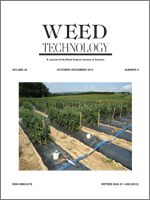Flucarbazone controls certain grassy weeds in wheat and may have potential for controlling perennial ryegrass in tall fescue turf. The objective of these experiments was to investigate perennial ryegrass and tall fescue tolerance to flucarbazone at two application timings. In field experiments, flucarbazone applications in May were more injurious to both species than in February and March. Single applications of flucarbazone from 30 to 60 g ai ha−1 in May injured both species 35 to 50% and sequential treatments increased injury approximately twofold. Two applications of flucarbazone at 60 g ha−1 in May injured both grasses > 90%, similar to sequential applications of trifloxysulfuron at 29 g ai ha−1. In growth chamber experiments, injury from flucarbazone on both grasses increased as temperature increased from 10 to 30 C. Flucarbazone reduced total shoot biomass of both grasses at all temperatures after 4 wk. Overall, perennial ryegrass and tall fescue are tolerant to flucarbazone at moderate temperatures (10 to 20 C). However, injury increased substantially under warmer conditions (30 C), suggesting flucarbazone could control perennial ryegrass and tall fescue during late spring and early summer.
Nomenclature: Perennial ryegrass, Lolium perenne L.; tall fescue, Festuca arundinacea Schreb.
Flucarbazone controla varias malezas gramíneas en trigo y puede tener potencial para el control de Lolium perenne en el césped Festuca arundinacea. El objetivo de estos experimentos fue investigar la tolerancia a flucarbazone de L. perenne y F. arundinacea en dos momentos de aplicación. En experimentos de campo, las aplicaciones de flucarbazone en Mayo fueron más dañinas en ambas especies que las aplicaciones en Febrero y Marzo. Las aplicaciones de flucarbazone de 30 y 60 g ai ha−1 en Mayo dañaron ambas especies 35 y 50% y los tratamientos secuenciales incrementaron el daño aproximadamente al doble. Dos aplicaciones de flucarbazone a 60 g ha−1 en Mayo dañaron ambos zacates, similarmente a las aplicaciones secuenciales de trifloxysulfuron a 29 g ai ha−1. En cámaras de crecimiento, el daño causado por flucarbazone en ambos zacates aumentó cuando la temperatura incrementó de 10 a 30 C. Flucarbazone redujo la biomasa aérea en ambos zacates en todas las temperaturas después de 4 semanas. En general, L. perenne y F. arundinacea fueron tolerantes a flucarbazone a temperaturas moderadas (10 a 20 C). Sin embargo, el daño incrementó sustancialmente bajo condiciones más calientes (30 C), lo que sugiere que flucarbazone podría controlar L. perenne y F. arundinacea tarde en la primavera y temprano en el verano.





